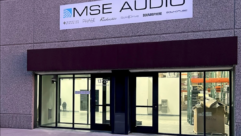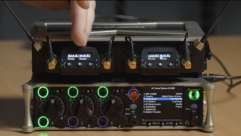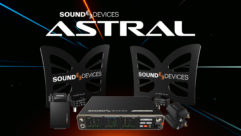
Understanding Home Theater Audio
Aug 11, 2010 10:58 AM,
By Bob McCarthy
Putting large-scale and small-scale audio in perspective.

I grew up in the age of stereo. Yes, there was a time when stereo was such a novelty that records would have a label on them to indicate this special feature. I listened to these recordings in my living room, bedroom, and later, dorm room, all the while preparing myself for my ultimate goal: to see the band in concert. The concert inevitably set up a compare-and-contrast scenario to my home listening experience. In the world before music videos (the inverse equivalent of the silent movie), the concert setting provided a personal level of engagement that the recorded experience could not match. On the other hand, the sonic intimacy of the home stereo was never translated into the theaters and arenas. The sound experience was fundamentally unmatched, with the big hall sound being both larger and smaller than my home experience. At home, the mix of the band was in front of me, stretched out along a line from the left loudspeaker to the right, but nowhere else. In the concert setting, the band originates from a small pinpoint, and then surrounds us with complex reverberation from all directions.
At the time, I surmised that these differences could be lessened by superior loudspeaker technology, and indeed there have been tremendous advances in the field. Today, the age of stereo has long faded to the age of earphones, and as a result, the disparity between live and Memorex is as great as ever. What I did not understand as youth, but grasp now, are the laws of physics and psychoacoustics at play that preclude the possibility of making the arena concert experience the same as our home theater, or earbud, frame of reference. These laws are not subject to repeal.

Figure 1. Compare and contrast the stereo experience in the home with that of the arena at 100Hz. Top: The home listening area falls almost entirely within the ±5-millisecond area, leaving open the possibility of panoramic stereo. Bottom: The wide spacing of the arena loudspeakers leaves only a small fraction of the listeners inside the central ±5-millisecond window.See a larger image.
To scale or not to scale
That is the question. Some aspects of sound transmission and the listening experience can simply be rescaled from small to large. The most notable of those is level. If the shape of my living room is the same as that of the arena, the SPL distribution over the space is largely unchanged. The difference in direct sound level from the middle of the room to the far end would be about 6dB in both cases, even though the difference in actual length might be more than 50 meters. This is because SPL distribution functions as a ratio (-6dB per doubling of distance), which makes it self-scaling to venue size. The experience for individuals within the space may vary because the size of the humans does not rescale. Whereas the home scenario has all listeners very near the center of the room, the arena has listeners scattered from front to back and side to side. Visualize home listeners within an inch of the loudspeakers and pushed up against the walls, and you have begun to grasp the level distribution challenges in an arena.
The next parameter to consider is time. In contrast to the ratio-based (logarithmic) world of level, time is strictly about differences (linear). If we compare the reflection paths of our home and arena scenarios, we can see no discernible difference. Angle of incidence equals angle of reflection, and around the room we go. The difference, however, is the difference: the amount of time elapsed between the direct sound and a given reflection. A back wall reflection at home arrives at a central listener within a 5-millisecond-to-10-millisecond window of the direct sound. The same path in the arena can easily exceed 250 milliseconds. The direct/reflected level component is almost the same in both cases (assuming comparable surface reflectivity), but the time gap between the direct and reflected sound is a world of difference in our minds. Our brains use timing information to discern between tonal modifying short reflections (cup your hands and talk to demonstrate) and long reflections that create discrete echoes…echoes…echoes. The walls of our living room are close enough that their reflections are perceived as fused to the direct sound. It is highly unlikely that we will consciously perceive the individual wall surfaces as sound sources. The identical geometry in an arena creates reflections that can become unhinged from the direct sound. Transient responses can be localized wherever glass and steel are found, creating a widespread marching band out of a single drummer. Steady state responses, such as that of the bass guitar, will be held in the room until long after the band has moved to the next note.
Wavelength
The working range of most sound systems runs from around 18kHz down to 30Hz. This is a ratio of 600:1, and that number corresponds to the difference in size of the wavelengths over that range. The sizes of these wavelengths run from fingernails to intermodal shipping containers. The wavelengths in your living room are the same size as in the arena, but the way they fit into the room shape is vastly different. How many shipping containers can you fit into your home listening area? That is how cramped 30Hz feels in your home. The arena is the open road by comparison, and this opens up a mixed bag of possibilities. The first is that we have enough space in an arena to exert some control over the low frequencies, and the second is how urgently we need to. Control of sound requires a loudspeaker system with extended length and/or depth, both of which are in short supply in the home environment. Therefore, the distribution/control of low frequencies in the home is, in most cases, little more than wishing and hoping and perhaps some expenditures on bass traps, etc.
In the arena, we must get control of the sound because the reflection timing is so long that it is destructive to the intelligibility. Control is exerted over the wide range of wavelengths by use of horns, waveguides, coupled loudspeaker arrays, and even exotic cardioid steering configurations. With large arrays, it is possible to mold the spatial distribution of the sound to the shape of the space, over a very wide frequency range. There is no practical equivalent in the home. The lows are sure to run wild through the room. Fortunately, the consequences are less dire.
Understanding Home Theater Audio
Aug 11, 2010 10:58 AM,
By Bob McCarthy
Putting large-scale and small-scale audio in perspective.

Figure 2. Compare and contrast the surround experience in the home with wall reflections in the arena at 100Hz. Top: The home surrounds create lateral sound from a small number of sources, creating a nondiffuse interaction at low frequencies and easily localized in the midrange. Bottom: The arena walls create diffuse reflections in the LF and create a spread spatiality over a wide frequency range.See a larger image.
Stereo rescaled
When you arrive at the arena concert, you see loudspeaker stacks on either side of the stage and immediately recognize the familiar stereo configuration of your home. This is a mirage. The reason is scale. The stereo experience does not translate into the big room because only one of the two vital parameters for stereo experience survives the change of venue: level. The time component does not rescale, and our binaural perception is incapable of neglecting that aspect. Stereo is a horizontal plane experience. To experience the smooth continuous panoramic placements of the recording studio mix, we must be in a position to have only one changing variable between the channels, and that position is dead center. As soon as we move off-center, the panoramic horizon becomes distorted and compressed. The time offset between the loudspeakers has a strong effect on localization, a factor that competes with and often dominates the level component. Time offsets of a few milliseconds are sufficient to overcome even relatively strong level panning. It will take 8dB of level pan to match just 5 milliseconds of time offset. In the home environment, we can stay close in time even when we sit a bit off to the side. The upscaled world of the arena, however, has very few seats within a 5-millisecond window of the left and right loudspeakers. Stereo separation is much more expansive in the studio world, but in the arena, we seldom find much more than a few tom drums and keyboard effects hard panned to either side. In cases where important instruments are moved apart, lots of people wonder why the mixer is only letting them hear half the show.
Surround scaled in reverse
Did somebody say flop? Betamax? No, that was video. For audio, flop is spelled “quadraphonic.” Back in the day, some folks thought the demise was due to format wars, but really it was all about totally missing the point. Surround in a small space was an attempt to reverse the direction of audio scaling—hoping to get the big hall qualities into the small space. Adding two loudspeakers in the rear corners did not fool anyone into thinking they were in a concert hall. It sounded like, for lack of a better explanation, two easily localized loudspeakers in the corners.
The modern 5.1 cinema-style surround system is able to take things a step closer. Sound images can be moved to the outer limits, but creating a seamless circle of sound requires an array of loudspeakers spread along the surfaces. This has practical limits in the home. Cinemas and musical theatrical productions use surround loudspeakers for special effects, but this is still a far cry from the complex multifaceted, multidirectional, spread-over-time reverberation that occurs in an actual large space. Once again, scale rears its head. In a large space, the full range of wavelengths are in a very complex weave, even the large low frequencies have sufficient space and decay time to envelop our ears with spatial clues. Meanwhile, in a small room, it is a challenge to localize the lows in any event, whether they are coming from one source or 10. The timing of the reflections is simply too close to discern separation. There are technological solutions that can recreate large-room acoustics in small, or acoustically dead spaces. These are reverberation enhancement systems that use densely spaced loudspeakers and recirculating microphones to replicate standard room acoustic responses. These are even used in rehearsal rooms that are no bigger than your living room and start at around $250,000.
Rooms big and small. Wavelengths big and small. Ears that stay the same size for all of them. Next time you see an ad that promises a true concert-hall experience in your home, you might consider this. Next time you hear that the concert will be mixed in stereo, you might pay the extra money to get a seat on the center aisle—after all, prices are scaled accordingly.
Bob McCarthy is president of Alignment and Design. McCarthy specializes in the design and tuning of sound reinforcement systems and conducts trainings around the world. His book, Sound Systems: Design and Optimization, was named “2007 Sound Product of the Year” by Live Design. Visit his blog at bobmccarthy.wordpress.com.










